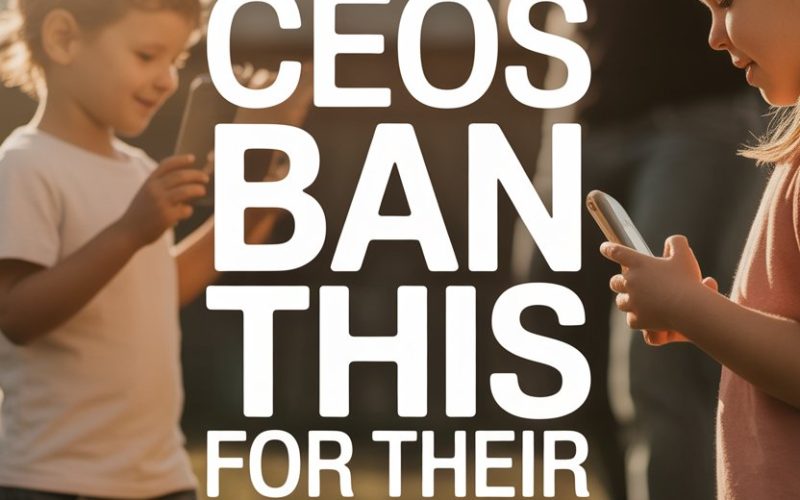Peek behind the glossy doors of Silicon Valley, and you’ll spot a curious trend: the very folks who build our screens are often the first to ban them at home.
If you’ve ever wondered why people designing tomorrow’s tech are busy hiding it from their own children today, you’re not alone.
Turns out, tech titans are parenting old-school, and there’s a lot the rest of us can crib from their playbook—without the need for a Stanford degree or a Montessori tutor on retainer.
Screens, Screens… Everywhere But Home
You might picture a tech CEO’s home as a futuristic playground: robot butlers, voice-activated everything, kids swiping before they can toddle.
In reality? Many of these homes look a lot more like your nan’s, at least when it comes to screen use.
Steve Jobs, when launching the original iPad, famously told a reporter his kids hadn’t even touched it. Bill Gates capped screen time for his offspring and banned smartphones before high school.
Sundar Pichai, Google’s head honcho, limits his son’s use of technology, too. There’s a reason these leaders are opting for wooden blocks over tablets at the dinner table.
Why Are Tech Leaders So Wary?
It’s not about being anti-progress or raising mini Luddites. The truth is, if anyone understands the magnetic pull and sneaky addictive nature of screens, it’s the people who designed them to be exactly that.
If the inventor of the biscuit keeps their own pantry biscuit-free, you might want to ask yourself what’s in the dough.
Recent studies back up their wariness. Screen time correlates with sleep disruption, attention issues, and even changes in brain structure in younger children, according to Oxford’s Internet Institute.
While the odd CBeebies binge isn’t going to fry any circuits, consistent, unregulated use is another kettle of fish.
What Tech Gets the Chop?
Smartphones top the list. Many Silicon Valley parents say their children won’t get their own mobile until secondary school, or even later. Social media apps are banned well beyond the minimum age limit.
Even e-readers and educational apps get a closer look—nothing slips past these parents without a thorough inspection.
Tech-free bedrooms are the norm. No screens after dinner, and absolutely none before school. Some ban television during the week, saving it for family movie night only.
It’s a touch ironic, really. The folks with the fanciest gadgets are the ones safeguarding childhood from them.
Why Does Screen-Free Matter So Much?
Beyond the science, there’s an emotional truth here: kids are happiest, and do best, when they’re face-to-face, not face-to-screen.
Social skills grow through squabbles over whose turn it is to push the toy pram, not whose Minecraft world is cooler. Family bonds deepen over board games, shared stories, and the sublime chaos of a living room fort—not a group chat.
Mental health also comes into play. Tech CEOs see the endless scroll for what it is: a black hole for self-esteem and focus.
They know dopamine-driven apps aren’t built for the well-being of tweens. No wonder this crew is holding out.
Old-Fashioned Fun Makes a Comeback
You’ll find tech CEO kids mucking about in the park, learning instruments, or cracking open an actual book (the kind with pages!).
Playdates mean real-life interaction, not Mario Kart tournaments. Family meals aren’t interrupted by notifications about new TikTok dances.
If it sounds quaint, that’s because it is. But these traditions are sticking for good reason.
The American Academy of Pediatrics points out that screen-free family time is linked with better grades, better sleep, and fewer behaviour bust-ups.
As it turns out, “have you tried turning it off and on again?” might apply to your parenting style, too.
Boundaries Over Blanket Bans
Not all tech CEOs are Luddites in disguise. The secret isn’t just walling off technology, but creating clear, hard boundaries—ones that sometimes even the adults struggle to follow.
The late Steve Jobs may have kept iPads away from his kids, but he also championed the dinner table as sacred ground. No gadgets at meals, and conversations that didn’t need a Google fact-check.
Setting device curfews, requiring screens to stay in shared spaces, or scheduling “unplugged” hours are all tools of the trade.
Tech designer and former Facebook exec Tim Kendall swears by a “phone box” at the entrance—mobiles go in the minute everyone’s home, and stay there until needed for outgoing calls.
It’s not about elimination, just about keeping screens in their place.
What If You Can’t Ban Screens Completely?
Here’s the comfort: you don’t need to live like an Amish offshoot. Tech CEOs aren’t running screenless communes; they’re just strategic.
For families juggling work calls, remote learning, and a child’s insatiable need for Bluey reruns, moderation is the golden ticket.
Screen time contracts work wonders (especially with older children). Write them together: decide what, when, and where screens are okay—and enforce with the resolve of a chocolate-guarding Easter bunny.
Use tech for connection, not isolation. Co-watch, co-play, co-create. Don’t plonk a tablet in front of a tired child and scarper; instead, curl up for a cartoon, then chat about it.
Research from Common Sense Media found that co-viewing boosts comprehension and emotional regulation, not to mention family giggles.
Model the Screen Habits You Want
Cue awkward silence as you check Instagram in the soft glow of your own phone. Kids are little sponges, soaking up what they see. If everyone’s glued to their device after a long day, it’s tough to sell the “screens rot your brain” narrative.
Tech CEOs make a point of showing their own restraint. Phones go away during family time, laptops close after the workday.
Need to check emails? Say it out loud, explain why—and then step away once you’re done.
It’s about being present, even if your own phone is buzzing with WhatsApp group chat memes.
What About Social Pressure?
“My mates all have iPhones!” If you haven’t heard it yet, you will. Tech CEO parents stare this one down with a knowing smile.
Their secret weapon? A big helping of “not in our house,” plus a dash of empathy.
They talk to their children about why the rules are different, not just bark orders. Conversations about privacy, digital footprints, and the real reasons behind age guidelines matter—much more than “because I said so.”
This approach is echoed by child psychologist Dr. Michael Rich, who recommends letting kids in on the reasoning. When children understand the “why,” they’re far more likely to buy in—even if the whining continues.
Building a Tech-Savvy, Not Tech-Obsessed, Child
No CEO is raising a child to be a digital Neanderthal. They want their kids to be creative, curious, and comfortable with technology—just on their own terms.
Coding classes, robotics kits, and podcasts become tools for learning, not just entertainment. Screen time is intentional, purposeful, and almost always shared.
The internet’s wild west is approached with healthy scepticism and parental supervision, not carte blanche.
Digital literacy becomes a family conversation. What’s real? What’s clickbait? What’s a sneaky ad and what’s a safe site? These kids aren’t just shielded; they’re equipped.
Don’t Panic: You’re Not Years Behind
If you’re reading this while your child polishes off their third YouTube video of the morning, take a breath. No one’s perfect, and even the tech elite occasionally cave to the lure of Cocomelon when the clock strikes dinner prep.
Start small. Pick one meal a day that’s screen-free. Try a family walk with everyone’s devices left at home.
Set up a charging “dock” in the kitchen, not the bedroom. Celebrate the wins, forgive the slip-ups, and remember—consistency beats perfection every time.
Raising Kids Like a Tech CEO (Without All the Stock Options)
Turns out, the world’s techiest parents aren’t anti-technology—they’re fiercely pro-childhood. They know devices are designed to hook us, and they’re not about to let their children be the catch of the day.
With a bit of intention, a sprinkle of humour, and the odd “put that phone down or else,” you can give your kids the same gift: a childhood filled with conversation, curiosity, and the kind of memories that don’t pop up just in a Facebook feed.
For busy parents, that’s the real upgrade.





